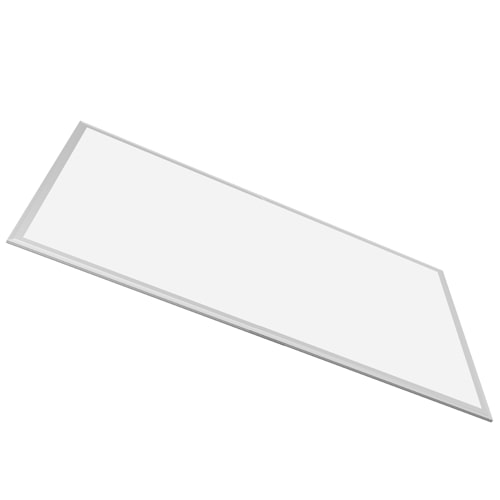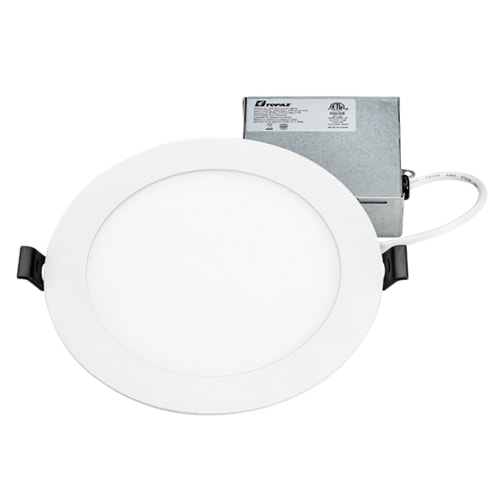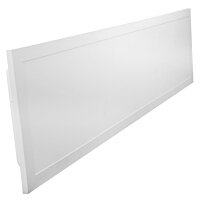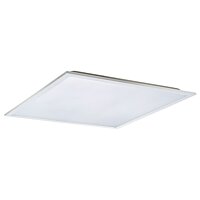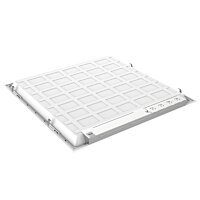Types of Drop Ceiling/Tile Ceiling Lighting Fixtures
Recessed lighting: Recessed lights, or downlights, are installed directly into the ceiling panels, creating a flush appearance. They provide focused, directional light and are often used for task or accent lighting.
Troffer lights: These rectangular or square fixtures are designed to fit into standard 2x2 or 2x4 ceiling grids. They provide even, diffuse light, making them ideal for general or ambient lighting in commercial and office spaces.
Suspended linear lighting: Linear lights, or pendant lights, hang from the ceiling grid via suspension cables or rods. They can be used for both ambient and task lighting and are often used in commercial and retail settings.
LED panel lights: These thin, energy-efficient panels are designed to replace traditional fluorescent troffer lights. They provide even, glare-free illumination and are suitable for a variety of applications depending on the size of the fixture. Drop ceiling LED panel lights typically come in sizes of 2x4, 2x2, and 1x4.
2x4 LED Flat Panels: 2x4" refers to the size of the panel in feet, meaning the panel is approximately 2 feet by 4 feet. These panels are designed to provide a large, uniform source of light, typically replacing traditional fluorescent troffers. They're called "flat" because they have a slim profile, usually only a few inches thick, which allows for a modern, streamlined look in a room.
2x2 LED Flat Panels: 2x2 LED flat panels are similar to 2x4 panels but, as the name suggests, they are smaller, approximately 2 feet by 2 feet in size. These fixtures are commonly used in various indoor spaces such as offices, schools, hospitals, and retail stores. They are designed to fit into a standard T-bar grid used for drop ceilings, but they can also be mounted directly to a ceiling or wall with the appropriate hardware.
1x4 LED Flat Panels: 1x4 LED flat panels are yet another type of LED light fixture, with the dimensions being approximately 1 foot by 4 feet. They're designed to provide bright, even lighting and are ideal for various applications such as offices, retail spaces, schools, hospitals, and more.
CCT Tunable/Wattage Selectable LED Flat Panels: CCT Tunable and Wattage Selectable LED Flat Panels are advanced types of LED light fixtures that offer customizable lighting experiences to users. CCT Tunable: CCT stands for Correlated Color Temperature. It's a measure of the color of light produced by a light source, measured in Kelvin (K). Lower values (like 2000-3000K) correspond to warmer (more yellow/orange) light, while higher values (like 5000-6500K) correspond to cooler (more blue) light. On the other hand, wattage selectability means that you can adjust the power consumption of the light fixture, which in turn affects its brightness.
Types of Drop Ceiling Light Bulbs
Drop ceiling lights or tile ceiling lights can use several types of bulbs or light sources.The choice of bulb depends on the specific fixture, the desired lighting effect, and energy efficiency considerations. LED technology has become the most popular due to its numerous advantages, and many businesses and institutions are retrofitting their old fluorescent fixtures with LED panels or LED tubes.
Fluorescent Tubes: Traditional drop ceiling lights often use linear fluorescent tubes, such as the T8, T5, or older T12 sizes. These are relatively energy-efficient and have good color rendering, but they do contain mercury and require careful disposal.
Compact Fluorescent Lamps (CFLs): These are essentially miniaturized versions of full-sized fluorescents. They screw into a standard light bulb socket and are often used in smaller fixtures.
LEDs: Nowadays, many drop ceiling lights use LED (Light Emitting Diode) technology. LED panels or tubes are extremely energy-efficient, have a very long lifespan, and do not contain mercury. Some LED fixtures don't use "bulbs" in the traditional sense, but have integrated LEDs that are built into the fixture.
Incandescent and Halogen Bulbs: These are less common in drop ceiling lights because they are less energy-efficient and have a shorter lifespan. However, they might still be used in some settings for their warm light and excellent color rendering.
Metal Halide and Other HID Lamps: High-intensity discharge (HID) lamps, including metal halide, high-pressure sodium, and others, are sometimes used in commercial or industrial settings. However, they're less common in typical office or retail environments.
As previously discussed, LEDs have become by far the most popular type of lighting for office and commercial drop ceilings. Always be sure to check the specifications of your particular light fixture to ensure that you're using the correct type and size of bulb.
Drop Ceiling Lighting Requirements
Drop ceiling lighting requirements will vary depending on the purpose of the space, the desired ambiance, and local building codes. With that said, there are some general guidelines that our commercial led lighting experts have put together for the benefit of the reader.
Lighting uniformity: Achieve uniform illumination by evenly spacing light fixtures throughout the space. Uneven lighting can create dark spots or glare, which can be uncomfortable for occupants.
Illuminance levels: Determine the required illuminance levels for the space, which is usually measured in foot-candles (fc) or lux. Common recommendations for various spaces are:
- Offices: 30-50 fc (300-500 lux)
- Retail: 20-50 fc (200-500 lux)
- Residential: 10-20 fc (100-200 lux)
- Storage or utility areas: 5-10 fc (50-100 lux)
Here are more specific drop ceiling lighting requirements for specific applications:
| Application | Illumination Level in Lumens/Square Meter (lux) | Illumination Level in Foot Candles (fc) |
|---|---|---|
| Office/Cubicle Areas | 500 | 40.45 fc |
| Conference Rooms | 300 | 27.87 fc |
| Training Facilities | 500 | 40.45 fc |
| Indoor Corridors | 200 | 18.58 fc |
| Bathrooms | 200 | 18.58 fc |
| Locker Rooms | 200 | 18.58 |
| Janitorial / Storage Areas | 200 | 18.58 |
| Lunchroom & Dining Areas | 150-200 | 13.94-18.58 fc |
| Kitchens | 500 | 40.45 fc |
| Child Care & Education Centers | 500 | 40.45 fc |
Drop Ceiling Lighting Pricing
The cost of drop ceiling lighting can vary widely depending on factors such as the type of lighting fixtures, the number of fixtures, the complexity of the installation, and local labor rates. Here's a general breakdown of the costs associated with drop ceiling lighting:
Lighting fixtures: The cost of lighting fixtures for a drop ceiling can range from $10 to $200 or more per fixture, depending on the style, design, and quality of the product.
Accessories and supplies: You may need additional materials, such as mounting brackets, wiring, and electrical boxes, which can add to the overall cost. These items typically range from $5 to $50 per piece, depending on the type and quality of the product.
Installation: The cost of installation will vary depending on the complexity of the project, the size of the area, and local labor rates. On average, electricians charge between $50 to $100 per hour for their services. The installation process for drop ceiling lighting might take anywhere from 2 to 8 hours or more, depending on the number of fixtures and the specifics of the project.
The drop ceiling lighting fixtures offered at our store generally range from $39.99 to $140 per fixture.
LED Drop Ceiling Lighting Guide
Large indoor spaces often use drop ceilings as a cost effective and aesthetically pleasing form of ceiling finishing. This accomplishes several engineering purposes, namely to provide insulative properties while allowing access to things such as plumbing, ventilation ducts, electrical lines, etc. In order to provide lighting for these spaces, specially designed light fixtures are intended to seamlessly integrate into these drop ceiling systems.
Traditionally these drop ceiling lights were of the fluorescent type, using T12 and T8 size tube lights. However in recent years, LED technology has come to dominate the drop ceiling marketplace with various designs intended to replicate traditional fixture types. There are several reasons for this, namely the increased energy efficiency as well as longer service life and a higher quality of light produced. Drop ceiling lighting comes in various options to fit a range of different applications, as described below.
Selection Factors
One of the first factors in selecting a drop ceiling LED lighting fixture is the dimensions or mounting size required. Drop ceiling lights typically come in 2’x4’ and 2’x’2 sizes, and it is obvious that knowing which size the ceiling requires is the first step in selecting a new fixture. Certain ceilings may require retrofitting in order to properly mount modern LED fixtures, especially if they use an odd sized ceiling tile arrangement such as a 6”x48” or 5”x84”. If a brand new drop ceiling is being installed, this takes any headache out of the equation due to the tile configuration being set up from the beginning to work with modern lighting.
Secondly, it is important to know the lumen requirements for the fixtures, which varies depending on application. In the past this was relatively simple, as the output of fluorescent tubes was normally measured in watts. However, due to the dramatically increased energy efficiency of LED technology, this is no longer a relevant or accurate way of measuring light output. Instead, lumen ratings are the standard of measuring a light's output, providing an equal comparison regardless of the technology used.
A factor that most do not consider is the color temperature of the light itself. In the past, this was pretty limited due to the range of color options available with fluorescent lights. However, with LED lights there are a range of color temperatures available, allowing the user to tailor the lights to each specific environment. This is hugely beneficial for retail and office environments where the color temperature used can have a significant impact on customer sales as well as worker productivity.
Drop-Ceiling Troffer Lights
Our LED Troffers provide an excellent replacement for existing fluorescents. A perforated lens guard coupled with a Flex-Diffuser™ emits an ultra-soft light that is ideal for computer work. Use X-Series LED T8 lamps for optimum light levels, while saving up to 60% over traditional fluorescents.
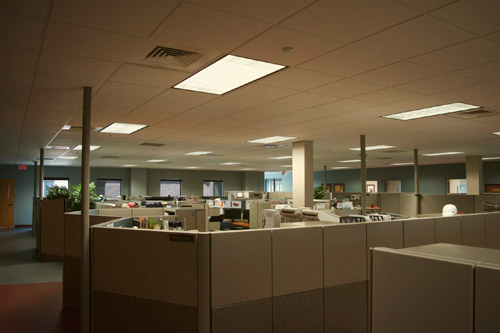
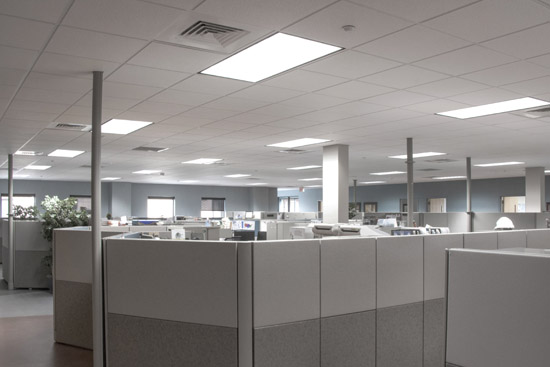
Current Annual Lighting Cost
LED Annual Lighting Cost
LED Retrofit Cost
Annual Savings with LED
Financial Summary
Environmental Impact
Commercial Office Lighting
By far the most popular use of drop ceiling lighting is in commercial applications, especially large scale operations such as corporate offices. Efficiency and ease of maintenance is the name of the game in these facilities, which makes drop ceilings a default choice for any building manager or interior designer. The use of LEDs in these drop ceiling lights is hugely beneficial, in that it provides not only higher energy efficiency but also a longer lifespan - both of which can save tremendous amounts of money overtime.
In addition to this, LED lights offer significant improvements in lighting accuracy, which is measured using the Color Rendering Index. This has multiple benefits, the first being a more pleasant work environment due to reduced eye strain as well as the absence of flickering associated with fluorescent lighting traditionally used in these applications. The increase in visibility not only increases worker productivity, it also has a major effect on improving safety by reducing the number of accidents resulting from poor visibility and eye fatigue.
Drop-Ceiling Lights Layout Design
As with any lighting setup, it is important that drop ceiling lighting is configured properly with a custom designed photometric layout. This will result in the best possible setup, ensuring both maximum energy efficiency and lighting effectiveness. There are several factors that come into play when setting up a drop ceiling photometric plan, namely the lumen requirements of the specific application, as well as ceiling height and the physical dimensions of the area being illuminated.
When ceiling height is known, a fixture with the appropriate foot candle rating and beam angle to provide optimal coverage can be selected. The next factor playing into this will be room dimensions, which is a bit more tricky - especially for rooms with irregular dimensions. Simply using the square footage of a room to calculate the number of fixtures is not sufficient - instead, it is key that the fixtures are orientated in the most effective manner for the particular space. This can sometimes result in different size or wattage fixtures for certain parts of a room in order to provide optimal coverage.
Because of the variance in these factors and how they interact with each other in each unique application, designing the ideal drop ceiling setup is a complex task with significant amounts of planning and calculations involved. Recognizing the challenge this poses for end users and the importance of a properly designed lighting plan, we offer our own in-house professional photometric planning in order to ensure our customers end up with the most efficient and effective lighting solution for their specific application.
To illustrate our photometric planning capabilities, below is an example of a drop ceiling lighting photometric design for a commercial office space that our photometric experts created for a building manager. This plan is specifically designed for a 15’ x 20’ area, with a 10 foot tall ceiling, covering 300 square feet in total.
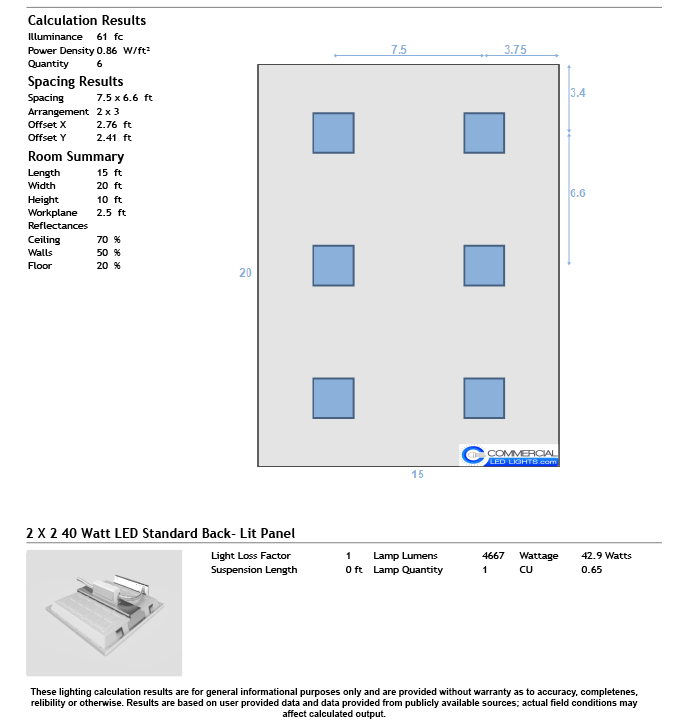
This plan not only covers details such as the applications foot candle requirements, but also the number of fixtures required to achieve this as well as their total lumen output, fixture wattage, etc.
Frequently Asked Questions
Q. Do drop ceiling LED lights require modifications to existing ceiling setups?
Generally speaking, these are direct replacements for any existing traditional lighting fixture, with the same dimensions and attachment methods. For ceilings where additional fixtures will be added, then there may be modifications required such as additional wiring or the removal of existing ceiling panels or other obstructions.
Q. Is it possible to convert existing drop ceiling fixtures to LED?
Yes, this is a popular option many choose. There are multiple types of LED T8 tubes that are available, with ballast ready or ballast bypass options. This gives end users the ability to have direct drop in tubes for easy installation or to rewire their fixture for ballast bypass, simplifying long term maintenance and eliminating the need for ballast replacement. Certain tubes have special circuitry that allows them to function with or without a ballast.
Q. How far apart should drop ceiling lights be mounted?
There are multiple ways in which this can be determined, the most accurate and precise method involving a proper photometric study. This will not only determine the correct spacing but also the number of overall fixtures as well as their placement and orientation within an area. However, a basic rule of thumb for drop ceilings in the lighting industry is to divide the mounting height by two and use that resulting number as a guideline for spacing. For instance, a ten foot mounting height would result in fixtures spaced five feet apart.
Q. How do I install drop ceiling lights in drop ceilings?
This is a pretty straightforward process, as most drop ceilings use standardized 2x2 or 2x4 size panel grids which a troffer, flat panel or other type of drop ceiling light fits directly into. In certain cases, modification of nonstandardized drop ceiling grids may be required, and if there is no pre-existing wiring present then a qualified electrician or lighting contractor will need to go through and wire the drop ceiling lights.


